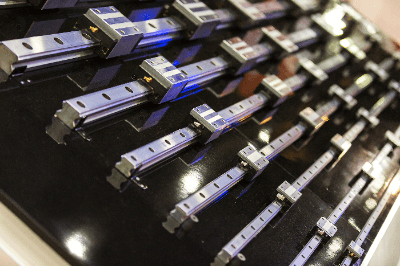What Is a Linear Motion System?

A linear motion system is a mechanical element that guides parts by reducing friction in linear motion.
To reduce friction, metal balls are generally used. Some use rollers or high-performance engineering plastics. The balls roll between the conveyor platform and the straight rail and move on the rail while supporting the weight. The balls can circulate on the conveyor table.
Linear motion systems allow smooth movement with little force. The precision-machined guide rails and balls have a little rattle, and the rotation of the balls is accurately transmitted to the transfer table, resulting in high positioning accuracy. Since the linear motion system have no propulsive force, it is used with ball screws, cylinders, or other mechanisms to move the transfer table in any direction.
Uses of Linear Motion Systems
Linear motion systems are used where precise linear motion is required. They are used in machine tool tables, conveying equipment, inspection machines, robots, etc. They are also used in wood processing machines, construction machinery, and automated machinery. Rolling of linear motion parts improves machine performance, such as higher precision, higher speed, and labor-saving in mechatronics equipment.
Its use is expanding to include liquid crystal manufacturing lines, railcars, welfare vehicles, medical equipment, seismic isolation and vibration control devices for high-rise buildings and housing, amusement equipment, drones, and printers. When precise linear motion is required, two guide rails are used. The mounting surface of the linear motion systems must be precisely machined.
Principle of Linear Motion Systems
Linear motion systems consists of a guide rail, a carriage block, balls, ball retainers, and return caps. The guide rail is attached to the structural member, and the conveyor block moves on the guide rail with the rolling motion of the balls.
The rolling surface of the guide rail has a groove with a radius similar to the ball’s diameter. Contact between the rolling surface and the balls is reduced from point contact to surface contact, greatly improving the allowable load and life. The structure of multiple rows of strips to support the ball enables accuracy to be maintained even under severe operating conditions, such as moment loads during rapid acceleration/deceleration and long continuous operation.
It is necessary to prevent unevenness in operation due to changes in the distance between the balls caused by their rolling during operation. Therefore, retainers are provided to keep the distance between the balls constant during operation. Linear motion systems are classified according to the accuracy of the balls and guide rails.
The higher the accuracy grade, the more restricted the operating environment, so it is necessary to calculate the load and consider the rated life before use. Some guide rails have offset gothic arch grooves in which the balls roll. They have the advantage of high static load capacity.
Types of Linear Motion Systems
There are two types of linear motion systems, the miniature type and the medium/heavy load type.
1. Miniature Type
This type consists of two rows of balls that contact the guideway raceway at four points. This type is used in situations where no particularly heavy load is applied.
2. Medium to Heavy Load Type
This type consists of four rows of balls that make contact with the guideway raceway at two points. This type is used for machine tools that perform heavy-duty cutting. The allowable load is increased by providing a groove for the balls to roll on the guideway.
3. Other Types
Some types do not use balls. Rollers, high-performance enplanes, oil-less metal, etc., are used for sliding parts. Compared to the ball type, this type has a larger load capacity and is more resistant to dust and other foreign matter. The disadvantage is the high frictional force.
Furthermore, in addition to straight rails, there are other types, such as cross guides and R guides. If high rigidity is not required, there is a compact, lightweight, and low-cost precision ball slide made by precision forming a stainless steel sheet into a U-shape and integrating the raceway portion and mounting surface.
Other Information on Linear Motion Systems
Features of Linear Motion Systems
Circulating ball-type linear motion systems are characterized by high rigidity, long life, high accuracy, quiet and smooth operation, and excellent vibration characteristics. Sliding-type linear motion systems that do not use balls are up to about 40% less expensive than ball-type linear motion systems. They are maintenance-free, lubricant-free, resistant to dust and moisture, have excellent corrosion resistance, are hygienic, have low noise, are lightweight, and have other advantages.